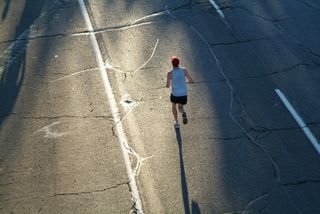Mario Music To Study To
Music Benefits Exercise, Studies Prove

With the Fall marathon season in total swing, thousands of runners are gearing up for the large day. Just as of import as their cleaved-in shoes and heart rate monitor is their source of motivation, inspiration and distraction: their tunes.
Running with music has go so common that the two biggest names in both industries, Nike and Apple, have been joined at the hip with the Nike + iPod combination. Then, what is it nearly music and running, or any exercise, that feels so right?
Several contempo studies try to hunt downwards the connectedness betwixt our ears and our anxiety.
For the terminal 20 years, Costas Karageorghis, a sports psychologist at Britain's Brunel Academy, has been setting the research footstep for agreement our demand to groove and move.
In addition to his lab research, Karageorghis has helped create a one-half marathon in London that tries to find the perfect music mix of alive bands based on his research of human being reaction to rhythm. The 2d annual "Run to the Beat" outcome was held a few weeks ago with 9,000 laboratory rats, er, runners either enjoying the alive music or listening to their ain mix of tunes on their MP3. Karageorghis even offered a scientific selection of songs based on his findings.
According to Kargeorghis, in that location are iv factors that contribute to a song's motivational qualities: rhythm response, musicality, cultural impact and clan.
The first two are known as "internal" factors as they chronicle to the music's construction while the 2nd 2 are "external" factors that reflect how we interpret the music. Rhythm response is tied to the beats per infinitesimal (bpm) of the song and how well it matches either the cadence or the heartbeat of the runner. A song'due south structure such as its melody and harmony contribute to its musicality. The external factors consider our musical background and the preferences we have for a certain genre of music and what nosotros have learned to associate with certain songs and artists.
Picking the right music tin have several benefits.
Syncing beats per minute with an exercise stride increases your efficiency. In a recent study, subjects who cycled in time to music found that they required 7 percent less oxygen to do the same work when compared to music playing in the background. Music can likewise assistance cake out the little vocalism in your brain telling you its fourth dimension to quit. Research shows that this dissociation effect results in a 10 pct reduction in perceived effort during treadmill running at a moderate intensity.
In the electric current study, published in the Journal of Sport and Exercise Psychology, 30 subjects synchronised their pace to the tempo of the music which was 125 bpm. Before the experiment, a pool of music was rated using a questionnaire tool (the Brunel Music Rating Inventory) which so selected the about motivational pieces for the treadmill test. The subjects were given a option of either pop or rock music.
When compared to a no-music control, the motivational synchronised music led to a xv percent comeback in endurance.
"The synchronous application of music resulted in much higher endurance while the motivational qualities of the music impacted significantly on the estimation of fatigue symptoms correct up to the bespeak of voluntary exhaustion," Karageorghis reported.
Matching the beats per minute of our music with our exercise heart rate too takes an interesting not-linear path, according to research.
Karageorghis found that when our hearts are performing at between 30 and 70 percent of maximum, we adopt a somewhat linear increase from ninety to 120 bpm. Withal, when we reach our anaerobic threshold between seventy and 80 pct of maximum, we prefer a bound in rhythm from 120 to 150 bpm. Above 80 per centum of maximum center rate, a plateau is reached where even faster music is non preferred.
Another new study by researchers from Liverpool John Moores University, and detailed online in the Scandinavian Journal of Medicine & Science in Sports, looked at the tempo bending differently. Instead of a mix of different songs at different tempos, they asked a group of cyclists to pedal to the same vocal over 3 different trials.
What the subjects did non know is that the researchers first played the vocal at normal speed, but then increased or decreased the speed of the same song by 10 percent. The small change was not enough to be noticed, but it did have an effect on operation.
Speeding upwardly the music program increased distance covered/unit time, power and pedal cadence past ii.1 pct, 3.v per centum and 0.7 percent, respectively. Slowing the programme produced falls of 3.8 percent, 9.eight pct and 5.ix percent. The researchers ended that we increase or decrease our work try and pace to match the tempo of our music.
Finding the correct beat out has now get fifty-fifty easier with a software plug-in tool called Tangerine. By integrating with your iTunes library, it can build a custom playlist based on the BPM range you provide, while arranging the songs in several dissimilar tempo shapes including warm-ups and warm-downs. With the correct mix, your encephalon and feet will be in perfect harmony.
Dan Peterson writes nigh sports science at his site Sports Are eighty Percent Mental. His Scientific discipline of Sports column appears weekly on Live Science.
Mario Music To Study To,
Source: https://www.livescience.com/5799-music-benefits-exercise-studies-show.html
Posted by: gonzalezcluounce.blogspot.com


0 Response to "Mario Music To Study To"
Post a Comment